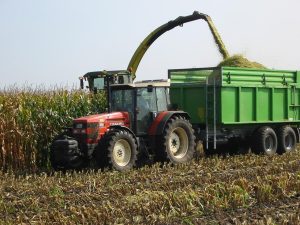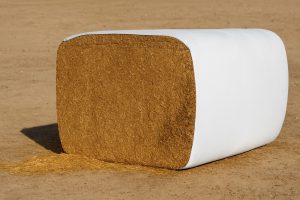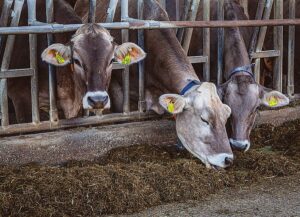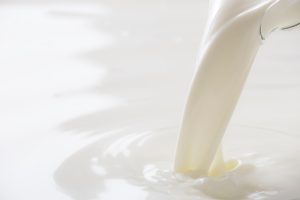Álvaro García
Alfalfa provides high protein, digestible fiber, and carotene, making it a vital component of dairy rations. How this forage is preserved influences not just its nutrient profile but also its utilization by dairy cows. Sun curing relies on natural solar drying, while dehydration involves rapid, high- temperature forced drying, often followed by pelleting. Both methods have advantages and risks: sun curing exposes forage to weather but avoids heat damage, while dehydration ensures rapid preservation but can compromise protein and vitamin availability.
This article compares the effects of the drying method on protein quality, fiber digestibility, vitamin retention, and cow performance.
Nutrient effects of drying and preservation
Heat during dehydration can trigger Maillard reactions, binding sugars to amino acids (notably lysine) and raising ADICP, the protein fraction considered unavailable. The early work by García et al. (1989) showed that temperature, moisture, and aeration act together to accelerate proteolysis and ammonia formation, the same risk factors when dehydrated alfalfa is overheated with residual moisture. Drying also affects fiber and vitamins. Crude protein may look similar on paper, but excessive heat can depress NDFD and degrade carotene, lowering nutritive value. Sun curing, while slower and weather-dependent, involves lower temperatures and therefore better preserves protein quality and heat-sensitive nutrients when conditions allow.
Because ADICP reflects unavailable protein, routine testing for it is essential. For example, if alfalfa is 20% CP with 12% ADICP, only 17.6% CP is usable by the cow. Ignoring this correction overestimates dietary protein and risks poorer microbial growth and milk yield.
Economic/production impact (MP-based):
Where alfalfa supplies 40% of intake (8 kg DM/cow/day), shifting from sun-cured (20% CP; 8% ADICP) to heat-damaged dehydrated (20% CP; 20% ADICP) drops available CP by 160 g/cow/day. If approximately 75% of that shortfall translates to MP, the deficit is close to 120 g MP/cow/day. Using around 48 g MP per liter of milk, which equals around 2.5 L less milk/cow/day. Scaled to 1,000 cows, the loss is almost 2,500 L/day. For a more severe scenario (e.g., larger ADICP gap doubling the MP deficit to around 240 g), expect close to 5.0 L/cow/day or 5,000 L/day per 1,000 cows.
Feeding trials mirror this pattern: with carefully controlled dehydration, quality can be close to sun-cured; with overheating, intake, nitrogen efficiency, and milk output fall. The main risk is not dehydration itself, but poor temperature control. Pellet hardness, inclusion rate, and dryer settings matter, but ADICP-verified protein availability remains the most dependable guide for ration adjustment.
Correcting Crude Protein for ADICP | ||||
Forage Sample | Crude Protein (% of DM) | ADICP (% of CP) | Available CP (% of DM) | Notes |
Sun-cured alfalfa | 20 | 5 | 19.0 | Minimal heat damage |
Dehydrated alfalfa (moderate heat) | 20 | 12 | 17.6 | Some lysine loss, ration adjustment needed |
Dehydrated alfalfa (severe heat) | 20 | 20 | 16.0 | High ADICP, major correction required |
Every 0.1 kg of lost available protein per cow per day can represent close to 1.1 liters less milk (based on 0.09 kg milk protein per liter). Using this relationship:
- Sun-cured alfalfa (19.0% available CP): Baseline, no milk
- Moderate heat damage (17.6% available CP): or 0.24 kg less available protein → approximately 2.7 liters less milk per cow per day.
- Severe heat damage (16.0% available CP): almost 0.6 kg less available protein → close to 6.6 liters less milk per cow per day.
Impact of Heat Damage (ADICP) on Available Protein and Milk Yield | ||||||
Alfalfa Type | CP (% DM) | ADICP (%of CP) | Available CP (% DM) | Available CP (kg/day)* | MP Shortfall (g/day) | Estimated Milk Loss (L/day) |
Sun-cured | 20 | 8 | 18 | 1.44 | – | – |
Heat-damaged dehydrated | 20 | 20 | 16 | 1.28 | ~120 | ~2.5 |
*Assumes 20 kg DMI/day, alfalfa at 40% of diet DM (8 kg DM). Milk conversion factor: ~48 g MP required per liter of milk. | ||||||
The economic impact can be substantial. Diets based on high-ADICP dehydrated alfalfa may provide 0.5 kg less available protein per cow per day, which can translate into 5–6 liters less milk per cow daily. Scaled to 1,000 cows, this equates to 2,700–3,000 liters of milk lost each day under severe heat damage, or about 1,350 liters/day under moderate conditions.
Nutrient Quality Indicators of Sun-Cured vs. Dehydrated Alfalfa | |||
Aspect | Sun-Cured Alfalfa | Dehydrated Alfalfa (High Heat) | Notes/Implications |
Crude Protein (CP) | 18–22% DM (typical) | 18–22% DM (similar on paper) | CP values appear similar, but quality differs |
ADICP (% of CP) | 5–10% (minimal heat damage) | 12–20% or higher if overheated | Higher ADICP = less usable protein |
Available CP (aCP) | ~90–95% of total CP | ~80–85% of total CP (lower if overheated) | Lower aCP reduces microbial growth and MP supply |
Fiber Digestibility (NDFD) | Preserved if drying is rapid | May decline due to heat effects on fiber | Impacts energy availability |
Carotene/Vitamin A precursors | Moderate sun bleaching, but lower heat losses | Often degraded significantly by high drying temperatures | Affects vitamin supplementation needs |
Palatability & Intake | Good if cured properly | Variable: may drop if pellets are too hard/overheated | Can reduce DMI and milk yield |
Risk Factors | Weather damage (rain, mold, leaf loss) | Overheating, residual moisture, pellet hardness | Different management challenges |
Testing and correcting for heat damage
Heat damage in dehydrated alfalfa is typically assessed by ADICP as stated above. For example, if alfalfa contains 20% crude protein (CP) but 4% is ADICP, then only 16% is truly available.
In rations where alfalfa contributes 40% of dry matter (about 8 kg DM/cow/day):
- Sun-cured alfalfa (20% CP, 8% ADICP): Available CP ≈ 1.44 kg/day
- Heat-damaged dehydrated alfalfa (20% CP, 20% ADICP): Available CP ≈ 1.28 kg/day.
This represents a loss of about 160 g CP/day per cow. With approximately 75% of that deficit carrying through to metabolizable protein (MP), the shortfall is 120 g MP/day. Since almost 48 g MP supports 1 liter of milk, the loss equals around 2.5 liters of milk per cow per day. Scaled to 1,000 cows, which is a potential reduction of close to 2,500 liters of milk per day if the diet is not corrected.
To prevent these losses, nutritionists can reduce reliance on heat-damaged forage, supplement high-quality protein sources like soybean or canola meal, and rebalance rations for both rumen- degradable protein (RDP) and rumen-undegradable protein (RUP). Routine ADICP testing and diet adjustments ensure cows maintain performance even when dehydrated alfalfa shows signs of heat damage.
Below is a compact severe-damage scenario scaled per 1,000 cows and using the same assumptions (alfalfa = 40% of DM = 8 kg/cow/day; CP = 20%; milk requires 48 g MP/L; 75% of CP loss carries to MP).
- ADICP = 25%
- Available CP = 6 × (1 − 0.25) = 1.20 kg/cow/day
- CP loss vs. sun-cured (1.44 baseline) = 0.24 kg
- MP deficit ≈ 0.18 kg
- Milk loss ≈ 0.18 / 0.048 = ~3.75 L/cow/day or 3,750 L/day/1000 cows
- ADICP = 30%
- Available CP = 6 × (1 − 0.30) = 1.12 kg/cow/day
- CP loss vs. sun-cured (1.44 baseline) = 0.32 kg
- MP deficit ≈ 0.24 kg
- Milk loss ≈ 0.24 / 048 = ~5.0 L/cow/day or 5,000 L/day/1000 cows
Moving from a moderate ADICP issue (20%) to a severe one (25–30%) can double the milk penalty from ~2.5 L to ~3.8–5.0 L per cow per day unless you correct the ration (reduce the damaged lot, add soybean/canola meal, and rebalance RDP/RUP).
Recommendations and conclusions
- Carefully control drying temperature during dehydration and avoid residual
- Regularly assess forage for ADICP to quantify protein
- Reformulate diets based on available CP rather than total
- Monitor milk yield, milk urea nitrogen (MUN), and intake closely when switching between alfalfa sources.
- Use sun curing whenever weather permits to minimize heat damage, while recognizing the risks of weather-related nutrient losses.
The comparison between sun-cured and dehydrated alfalfa is not about one method always being superior, but about managing risks. Sun curing preserves protein quality and carotene better, while dehydration offers reliability in poor weather but risks heat damage if not carefully managed. García et al. (1989) demonstrated how temperature, moisture, and aeration drive nitrogen losses— insights that remain critical when assessing dehydrated forages. By testing for ADICP and reformulating diets accordingly, producers can minimize the performance gap and protect milk production, often by as much as 2–3 liters per cow per day.
© 2025 Dellait Knowledge Center. All Rights Reserved.








